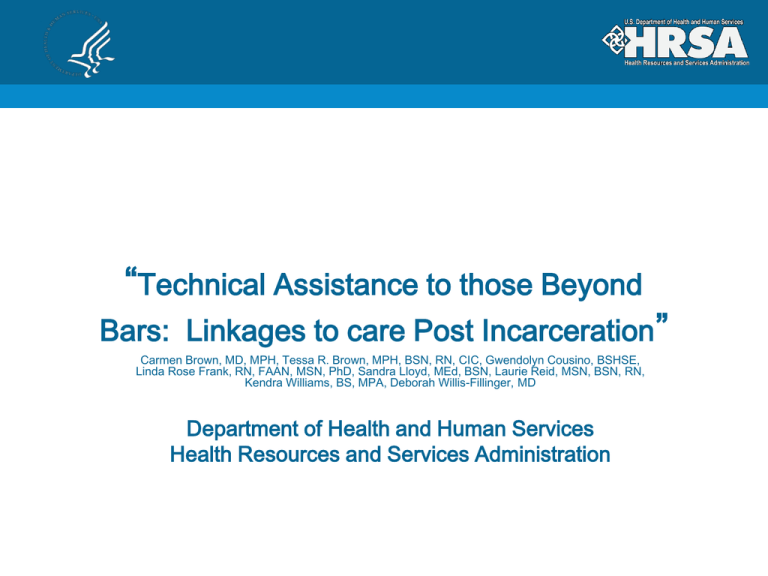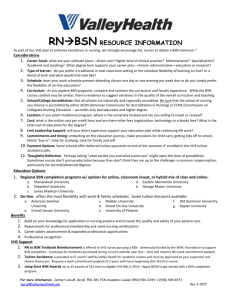E23 Technical Assistance to Those Beyond Bars
advertisement

“Technical Assistance to those Beyond Bars: Linkages to care Post Incarceration ” Carmen Brown, MD, MPH, Tessa R. Brown, MPH, BSN, RN, CIC, Gwendolyn Cousino, BSHSE, Linda Rose Frank, RN, FAAN, MSN, PhD, Sandra Lloyd, MEd, BSN, Laurie Reid, MSN, BSN, RN, Kendra Williams, BS, MPA, Deborah Willis-Fillinger, MD Department of Health and Human Services Health Resources and Services Administration Disclosures This continuing education activity is managed and accredited by’ Professional Education Service Group. The information presented in this activity represents the opinion of the author (s) or faculty. Neither PESG, nor any accrediting organization endorses any commercial products displayed or mentioned in conjunction with this activity. Commercial Support was not received for this activity. Disclosure Carmen Brown, MD, MPH, Tessa R. Brown, MPH, BSN, RN, CIC, Gwendolyn Cousino, BSHSE, Linda Rose Frank, RN, FAAN, MSN, PhD, Sandra Lloyd, MEd, BSN, Laurie Reid, MSN, BSN, RN, Kendra Williams, BS, MPA, Deborah Willis-Fillinger, MD Has no financial interest or relationships to disclose. CME Staff Disclosures Professional Education Services Group staff have no financial interest or relationships to disclose. Learning Objectives • Participants will analyze recent data and identify key factors associated with successful linkages to care post incarceration. • Participants will discuss best jail linkage practices being utilized and share challenges • Participants will identify grantee goals and next step for their local linkage projects. • Participants will create a learning community of grantees and providers focused on implementing linkages to care. Why linkages to care? • Reduce the number of people who become infected with HIV. • Increasing access to care and optimizing health outcomes for people living with HIV. • Reducing HIV related health disparities. EPI Data • Information to be added by Laurie Read from CDC/ all slides will be approved from the CDC. Shared Best Practices • To be added by SPNS or internal, (quick bullets, 7-8 minutes) • OR get summary of project. Sharing best practices Is any of the information presented so far new to you? Interactive Break Out groups • What are the challenges in linking released inmates to care? • What unique challenges do Nurses, Social workers and HIV Clinical Care providers encounter? • What challenges are unique to your setting? (U,R, S) How to link former inmates • Share: what works in linking clients? • Special techniques in engaging institutions or clients? AETC Curriculum development • Dr. Linda Frank to provide slides (7-12 minutes) Next Steps • How can we serve the post incarcerated effectively? • Who needs to be involved? • When can we start? • What can my organization do? • Where do we start? T/A from HAB • Development of distribution list from workshop participants • Networking with AETC, PA Thank you for everything you do! Obtaining CME/CE Credit • If you would like to receive continuing education credit for this activity, please visit: • http//www.pesgce.com/RyanWhite2012 Contact Information Carmen Brown: cbrown2@hrsa.gov Tessa Brown: tbrown2@hrsa.gov Wendy Cousino: gcousino@hrsa.gov Linda Rose Frank: frankie@pitt.edu Sandra Lloyd: slloyd@hrsa.gov Laurie Reid: axu2@cdc.gov Kendra Williams: kwilliams@hrsa.gov Deborah Willis-Fillinger: dwillis-fillinger@hrsa.gov











